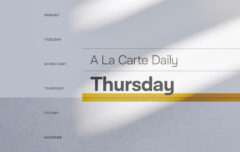It’s Reformation Day today. And no ordinary Reformation Day, either. This is the 500th anniversary of the day Martin Luther unintentionally began what would become a worldwide, world-transforming movement. And on this day I’m reflecting on some of my recent travels and how they’ve reinforced my gratitude for the work of Luther and the other Reformers. Here’s the video in YouTube and Facebook formats, followed by a transcript.
Rush Transcript
Happy Reformation Day. Is that a thing, Happy Reformation Day? If not it should be, it is now. Happy Reformation Day. As we come to this, this Reformation Day, we’re 500 years after Martin Luther nailed his 95 theses to the door of that cathedral in Wittenberg. As we come to this Reformation Day, I find myself especially happy, especially joyful to be Protestant. Stick around a little bit and I’ll tell you about it.
Over the past year I have set out on this project where I’m going around the world to look for my roots as a Christian. Really I’m going around the world looking for historical objects through which I can tell the story of this great Christian faith. I started my journey recently in Europe, and I want to tell you just a couple little snapshots, three actually, little snapshots of what I saw there, each of which in its own way made me so grateful to be Protestant. The first was actually the most recent when I was in Switzerland, and a friend and I we were walking through the city of Zurich and we came to a giant church, and we knew nothing about it, we weren’t able to read the sign to tell what it was all about. So we didn’t know as we walked in, is this a Protestant or is this a Catholic cathedral? What is this church all about?
We walked in and I thought, well how would I find the answer, I know, I just need to walk to the front of the room and see. We walked to the front of the room to the front of this church, and what did I see? I saw a pulpit with an open Bible on it. Right away I knew, this is a Protestant church, because a Protestant reformation was really a reformation about authority. Who has the authority to tell human beings who they are, what they must believe in, and especially how can they be made right with God. Well there was that open Bible at the front of the church rather than an ornate altar, rather than a host, a wafer, a piece of bread, rather than any of these trappings of Roman Catholicism was an open Bible. I knew right away that’s a Protestant church.
The other two snapshots come from the city of Rome, which is the first place I went on my journey. It’s a great place to start of course as you’re researching church history. Though you wouldn’t think it’s a place to go for reformation history, yet I found some things here that were pretty interesting. The first was the Scala Sancta, you’ve probably heard of these. These are sacred stairs, and legend has it these are the very stairs from the Palace of Pontius Pilate that Jesus had to walk up on the last night of his life. The mother of Constantine the Great took these steps and had them brought to Rome and set up there, and they quickly became a place of pilgrimage where devout Catholics would go. As I went there, they’re now housed inside this little chapel, this big chapel, I open the door and I walked in and right away what did I see is pilgrims going up these stairs on their knees. This is the tradition, this is how it’s been for centuries now.
Luther himself went to these stairs and when up em on his knees seeking to find joys, seeking to find hope, instead he found only further despair. Sure enough as I watched there, I saw these pilgrims going up step by step on their knees, pausing every step to do a Hail Mary, pausing every step to do a Lord’s Prayer, whatever it is. Then walking away joyful thinking they had now done something that was so good, and right at the bottom of the stairs was a placard announcing what would happen to those who climbed these stairs. It proclaimed that anyone who went up these stairs, on your knees, you must be on your knees, would receive an indulgence. You might think indulgences were done away with after the reformation, they are still fully in effect, they are still very popular, they’re still part of Roman Catholic worship.
The placard said if you go on a holy day up these on your knees with a proper spirit of penitence, you will have a full one year plenary indulgence. The punishment due to you in purgatory for all your sins for the last year will be wiped out. If it’s not a holiday you’ll get a partial indulgence, some of that will be wiped out. It was so sad to see these people going up there on their knees and to realize what incited Luther, what ignited the Reformation, was this matter of indulgences, it remains today.
The third little snapshot was from the Church of Jesus, it’s the head church of the Jesuit Order. The Jesuits of course founded in response to the Protestant reformation. As you walk into this giant, ornate cathedral, you look off to your right you’ll see the arm bone of Saint Francis Xavier there to be venerated. You’ll see people going there and bowing down before this mummified arm in this ornate reliquary holder of relics. What really interested me was on the other side of the room directly across from that was this giant altar, this giant chapel with this huge altar, and on both sides of the altar are these great statues, these great carvings. The one on the right is called The Triumph of Faith Over Heresy, and as you look you’ll see that first there’s this big figure of–is it Mary? Is it the church?–I’m not sure that it really matters, throwing these two men into hell.
You look carefully you might recognize them. One is certainly Martin Luther, the other I’ve heard that it’s John Huss, but I actually wonder if it’s John Calvin. The reason I say that is these men are being thrown into hell, they’re tumbling down, and there’s books falling with them. In fact there’s a cherub, an angel actually tearing one of their books apart, but as you look at the books you can look at the spine and you’ll see names written on the spine. On one is written “Mart. Luther,” on the other is written “Calvin.” So here are, I believe, Luther and Calvin and their books being thrown into hell. This is the Roman Catholic response to the Protestant reformation. Here we are 500 years later and that statue is still there, I even spoke to a priest and he defended it. He spoke of its value, and interesting to me, right beside that statue is a little placard.
When you read that placard, if you can read Italian, you’ll see that it promises indulgences for those who will go into a neighboring chapel and venerate a painting there. So again, the very things that ignited Luther 500 years ago, there they are alive and well in Rome today. I live in North America, many of you do, it’s easy in this part of the world to look around and think Catholicism has changed. You can walk into many Catholic churches and see them really unchanged, indistinguishable from Evangelical churches. That’s been a very deliberate move on the part of Roman Catholicism, but you go to Europe, you go these bastions of old Catholicism, you go to Rome, and you’ll see that what ignited the Reformation 500 years ago remains today.
The Catholic church declares it is semper eadem, unchanging, always the same. You look around and you’ll see that that’s the same. I’m thankful to be Protestant, I’m thankful for the work of Martin Luther and the other reformers because they returned scripture to the center of our life and faith, because they did away with the system of indulgences, they found in the scripture there’s no support for the system of indulgences, and because we can look at man like Luther and Calvin and trust them as teachers who led us back to the Bible, back to the truth that God reveals there. 500 years after Luther, 500 years after the Reformation, I’m very thankful to be Protestant.










